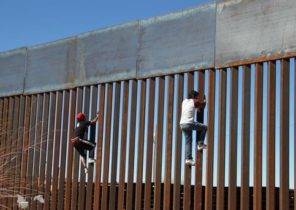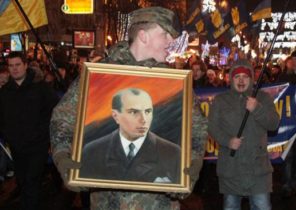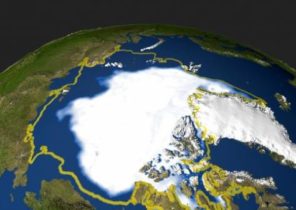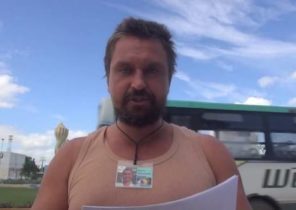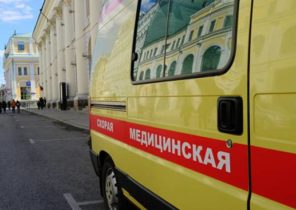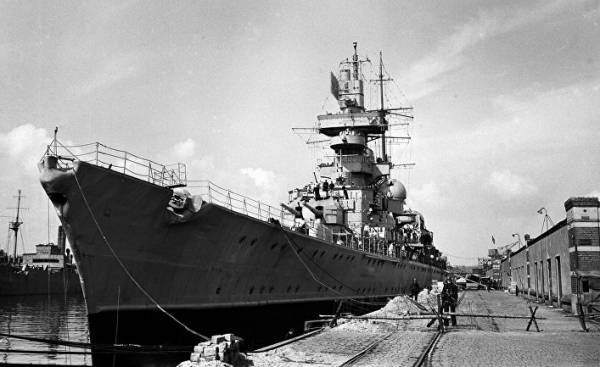
1 July 1946 in the Pacific was concentrated a huge fleet of the U.S. Navy. About 100 ships moored off the Bikini Atoll aircraft carriers and battleships, cruisers and submarines, destroyers and battleships. On Board there is not one person, but thousands of goats, pigs, rats, mice and Guinea pigs.
About nine o’clock the bombers dropped from a height of more than 8 thousand meters, for a fleet of nuclear bomb called the “Gilda” (“Gilda”). A few places scribbled on her picture pinup of Rita Hayworth (Rita Hayworth). Less than 150 metres above the water, the bomb detonates, and ignites a firestorm about 100 thousand degrees Celsius and creates a powerful blast wave. Destructive force throws warship “Gilliam” (“USS Gilliam”) on the seabed. The ships burn, their structures deformed.
Meanwhile, the only ship that survived the nuclear Inferno with almost no damage — “Prinz Eugen”. Heavy cruiser, launched in Kiel in 1938, when it was supposed to facilitate the victory of the naval forces of Hitler, and after the Second world war he served the United States as the experimental facility for testing nuclear weapons. This post-war story, Bauerfeind Ingo (Ingo Bauernfeind) in his book “Prinz Eugen”.
In 1938 Hitler was personally present in Kiel at the christening of a warship named in honor of the Habsburg military leader Prince Eugene of Savoy (Eugen von Savoyen), who struck in 1697 the Ottoman Empire a crushing defeat. In 1941, “Prinz Eugen”, together with the battleship “Bismarck” (“Bismarck”) was published in the Atlantic. With their length more than 210 meters and a caliber guns 20.3 cm they had to attack British merchant ships.
Rendezvous with the atomic bomb
He soon earns the nickname “happy ship”. Shortly before the end of may 1941 the “Bismarck” with more than 2 thousand people on Board was sunk in battle with the Royal Navy, “Prinz Eugen” went one. The cruiser repeatedly resisted air strikes and torpedoes broke through in 1942, the British blockade of the channel in the direction of Germany and later served as a training ship, and in the last months of the war was accompanied by the ships with refugees in the Baltic sea.
At the end of the war, “Prinz Eugen” anchored in Copenhagen. For the last large warship of the Germans fiercely fought the British and the Soviet Union. The U.S. Navy showed little interest. In the end, drew lots — as is customary, the captain’s cap.
Win a ticket to this the spoils of war went to the Americans. Since the beginning of 1946 on the “Prince Eugen” waving the star-spangled banner, while about 600 of the remaining German sailors were instructed by American officers and sailors on the management of ship’s equipment.
The engineers were impressed. Devices such as the system of hydrophones, or a catapult mechanism for side of the aircraft, had to be created later. Meanwhile, the Americans have already found a job for “Prince Eugen”: had prepared for him “rendezvous with the bomb,” this is the title of an article on the American Navy magazine All Hands in April 1946.
“Trembling in the lagoon”
At the end of January 1946 “Prinz Eugen” came out in the last voyage. On the pier in Boston was waiting army of journalists. “The”Prinz Eugen” has not yet fully moored, as one reporter tried to jump on Board,” recalled former crew member Dripped Franz (Franz Kapala).
Through the Panama canal, the cruiser reached the Pacific ocean, may 1, 1946, the Board left the last German sailors. Pure American crew was heading for the Bikini Atoll. There 1 July 1946 on the test fleet exploded “Gilda”. The explosive force was about 23 kilotons of TNT.
The strategy dubbed test series “Operation Crossroads” (“Operation Crossroads”), able (“Able”) — the first attempt was named the first letters of the then us military phonetic alphabet. Scientists wanted to document with cameras and instruments on ships, Islands and aircraft as the atomic bombing impact on living beings and materials.
RC boats took water samples to determine the extent of radioactive contamination, while watching the ships of the fleet were waiting at a distance. Finally, people also went to the test fleet after the radiation level was acceptable.
Despite this, people. “It is with some trepidation swam in the lagoon,” said future rear Admiral Robert Conard (Conard Robert). Most people did not have protective suits. They put out fires, collecting and measuring instruments, as well as the living and the dead experimental animals.
Sprayed in milliseconds
“Prinz Eugen” seemed to be unharmed. He was outside the zone of destruction because the pilot of the bomber missed the target from the real purpose of the ship “Nevada” (the”USS Nevada”), by as much as 600 meters. Design Japanese “Sakawa” (“Sakawa”), which was much closer to the scene of the blast, literally blown to pieces.
With only five sunken ships expected mass destruction, of course, did not take place. Therefore, many journalists simply left. And missed “the Baker” (“Baker”), the second test was expecting “Prince Eugen” and other repaired vehicles.
This time the atomic bomb was detonated at a depth of 27 meters. 25 July 1946 blew up the pillar of the millions of gallons of water for many kilometers in height. Landing ship, dropped anchor directly over the site of the explosion, smashed in seconds.
Waves up to 30 meters covered Islands, USA the explosion was registered as an earthquake of magnitude 5.5 points. The shock wave split the hull of the battleship Arkansas (“Arkansas”), USS Saratoga (“Saratoga”) is also sunk with heavy damage. All ships in the vicinity were seriously damaged.
Threat to the sea
“Prinz Eugen”, which was anchored about two kilometers from the epicenter, remained intact this time, apart from a few dents on the radar, of course, he was contaminated by radiation, as well as other ships and the Bikini Atoll. The crater, which was formed in the ground during test “Baker” was of a width of 600 meters and 9 meters in depth.
The Americans tried to decontaminate the ships, in contrast to the atolls. 5 thousand people were supposed to clean them with water, lye and soap. Divers, meanwhile, were raised from the bottom of the measuring devices from the sunken ships.
Meanwhile, was in full swing preparing for “Charlie” (“Charlie”). However, this third test is not meant to be. Budget cuts and doubts in the sense of continued testing completed the mission “Crossroads.” “Prince Eugen” was towed to nearby Kwajalein Atoll, to further observe its radioactivity.
Shortly before Christmas 1946 “Prinz Eugen” got a roll, possibly due to leaky valves. Despite all attempts of rescue, the cruiser sank on 22 December 1946. To this day its keel rises above the water. And despite stylee radiation, there remains a risk of up to three million litres of fuel left in the fuel tanks of the crumbling ship that is a threat to humans and the surrounding world.
